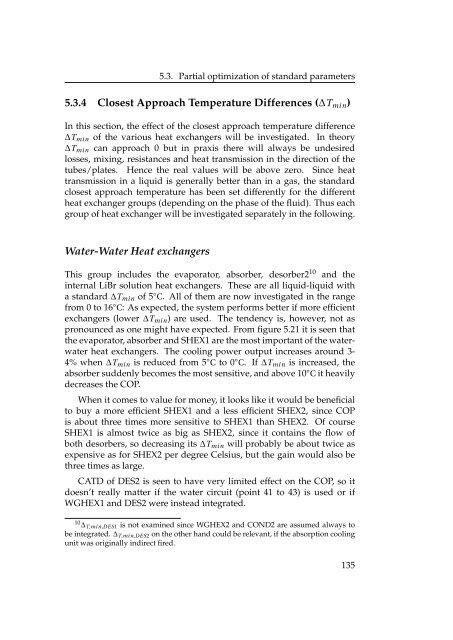integration of solid oxide fuel cells and ... - Ea Energianalyse
integration of solid oxide fuel cells and ... - Ea Energianalyse
integration of solid oxide fuel cells and ... - Ea Energianalyse
Create successful ePaper yourself
Turn your PDF publications into a flip-book with our unique Google optimized e-Paper software.
5.3. Partial optimization <strong>of</strong> st<strong>and</strong>ard parameters<br />
5.3.4 Closest Approach Temperature Differences (∆T min )<br />
In this section, the effect <strong>of</strong> the closest approach temperature difference<br />
∆T min <strong>of</strong> the various heat exchangers will be investigated. In theory<br />
∆T min can approach 0 but in praxis there will always be undesired<br />
losses, mixing, resistances <strong>and</strong> heat transmission in the direction <strong>of</strong> the<br />
tubes/plates. Hence the real values will be above zero. Since heat<br />
transmission in a liquid is generally better than in a gas, the st<strong>and</strong>ard<br />
closest approach temperature has been set differently for the different<br />
heat exchanger groups (depending on the phase <strong>of</strong> the fluid). Thus each<br />
group <strong>of</strong> heat exchanger will be investigated separately in the following.<br />
Water-Water Heat exchangers<br />
This group includes the evaporator, absorber, desorber2 10 <strong>and</strong> the<br />
internal LiBr solution heat exchangers. These are all liquid-liquid with<br />
a st<strong>and</strong>ard ∆T min <strong>of</strong> 5 ◦ C. All <strong>of</strong> them are now investigated in the range<br />
from 0 to 16 ◦ C: As expected, the system performs better if more efficient<br />
exchangers (lower ∆T min ) are used. The tendency is, however, not as<br />
pronounced as one might have expected. From figure 5.21 it is seen that<br />
the evaporator, absorber <strong>and</strong> SHEX1 are the most important <strong>of</strong> the waterwater<br />
heat exchangers. The cooling power output increases around 3-<br />
4% when ∆T min is reduced from 5 ◦ C to 0 ◦ C. If ∆T min is increased, the<br />
absorber suddenly becomes the most sensitive, <strong>and</strong> above 10 ◦ C it heavily<br />
decreases the COP.<br />
When it comes to value for money, it looks like it would be beneficial<br />
to buy a more efficient SHEX1 <strong>and</strong> a less efficient SHEX2, since COP<br />
is about three times more sensitive to SHEX1 than SHEX2. Of course<br />
SHEX1 is almost twice as big as SHEX2, since it contains the flow <strong>of</strong><br />
both desorbers, so decreasing its ∆T min will probably be about twice as<br />
expensive as for SHEX2 per degree Celsius, but the gain would also be<br />
three times as large.<br />
CATD <strong>of</strong> DES2 is seen to have very limited effect on the COP, so it<br />
doesn’t really matter if the water circuit (point 41 to 43) is used or if<br />
WGHEX1 <strong>and</strong> DES2 were instead integrated.<br />
10 ∆ T,min,DES1 is not examined since WGHEX2 <strong>and</strong> COND2 are assumed always to<br />
be integrated. ∆ T,min,DES2 on the other h<strong>and</strong> could be relevant, if the absorption cooling<br />
unit was originally indirect fired.<br />
135
















